When it’s time to sit down and write, do you find that your output is hit and miss? Would it be helpful to have clear expectations for each writing session before you move mountains to clear a few hours in your schedule? In this article, I’ll share a few eccentric best practices that have worked for me and may work for you as well.
We write to get our ideas out into the world and practice our craft. But for many of us, juggling this progress alongside work and family responsibilities can be a challenge. Additionally, the internet itself is intensely distracting; a study found that the average person is distracted every 40 seconds while at their computer.
3 Odd Workflows I Use To Get More Out Of Writing Sessions - Post Outline
I’m still distracted often, but having workflows has really helped my focus. Between this platform, client writing, and my monthly articles for Entrepreneur and Fast Company, I have a target of about 250 published articles this year. Pass the coffee, please! It means my writing muscles need to stay warm and in shape this year. Routines are essential for hitting this kind of output.
Hearing about other writers’ best practices can give you some new ideas or inspire you to tweak your approach for getting words on the page — especially when the advice is a little, well, strange. So here are three against-the-grain workflows I’ve adopted over the years that have really made a difference.
Related: Download the author’s free toolkit of 9 article templates right here.
#1: Separate Writing and Non-Writing Sessions–Then Do The Non-Writing Ones First
One of the best decisions I made last year was to abandon the idea of daily progress and focus more on weekly targets. Putting together an article has multiple steps: Research, outline, actual writing, editing, hero image, and headline to name a few.
I would try to declare a certain day my “writing day” and set my space up for success: Drop the dog off at daycare, have lunch and snacks ready to go, ensure my headphones were charged, and so on. This sounds great, and I love the idea of batching, but it’s never quite worked.
“Abandon the idea of daily progress and focus more on weekly targets.”
That’s because when I sat down to write, I would spend 50% or more of my session working on writing-related tasks and not actual writing. In some sessions I would kick out lots of words, and on other days I felt like I had spent my entire session going down a research rabbit hole or drowning in stock images.
I began to separate out my actual writing sessions from “non-writing” sessions. Originally I was writing first and doing administrative work second, but over time I found that it was easier to write when the administrative nitty-gritty was squared away and I had a really clear argument. Also, these non-writing sessions take less brain power; I can do them while listening to a podcast or watching TV if I want.
To start, I have a brain dump of a few hundred headline ideas sitting around on an incredibly messy spreadsheet. Once a week, I sit down, comb through a few of them, and outline potential articles I can write in the coming week. I ask myself questions like:
- Why would someone want to read this, and what will they walk away doing?
- What personal stories of mine could be worked into this topic?
- What stories from history or current events could be worked in?
- What template could serve as a good container for this piece?
I make these decisions in a session that is separate from my actual writing session. Then I do some research and outlining of that article idea. The writing comes last. Knowing which stage I’m in helps tremendously with progress.
#2: Abandon The Pomodoro Technique
My writing game definitely improved once I identified that I work best in increments of 90 minutes, followed by a 20–30-minute break. Productivity experts gush about the pomodoro technique (25 minutes on, five minutes off), but I find that cadence a little too disruptive.
Ultradian rhythm, in contrast, is a biological phenomenon similar to circadian rhythm that our bodies naturally go through each and every day. If you can ride one of these naturally occurring energy waves, you’ll find it way easier to concentrate.

For my pomodoro lovers, you can put three pomodoros into one ultradian rhythm wave if you really want to stick to your guns. When I’m able to get in the zone, I can make huge progress in an hour or two. The challenge is being able to get into the zone consistently.
#3: Do A Short Warmup
Sometimes I can pick up right where I left off on an article the following day because I have good momentum. Usually, though, it takes me a little time to get the boulder moving again, so I spend about 5 or 10 minutes “warming up” my brain.
I use the website 750 words as a space to freewrite each day. The name of the site is 750 words because that equates to about three pages; some days I make it to 750, but on most days I feel warmed up enough after 500 words or so to feel stretched out and ready for my session. If you want something a little more intense, Squibler’s Most Dangerous Writing App is the same concept, except that you’re timed and a pause of more than five seconds will cause your session to self-destruct. Jeez.
Just like your muscles during exercise, your writing becomes more fluid and stronger once you’re warmed up. Not every session is perfect, but I find that a short warmup almost always leads to better idea generation and bigger output in less time.
___
Everyone’s recipe for success is a little different, and with some tinkering you’ll discover over time what works best for you. That might mean going against mainstream writing advice or adopting weird habits to get across the finish line. Experiment with organization, treat writing like a muscle, and you’ll soon be able to squeeze more progress out of each precious session.
Thanks for reading. 🙏🏼
Keep up the momentum with one or more of these next steps:
📣 Share this post with your network or a friend. Sharing helps spread the word, and posts are formatted to be both easy to read and easy to curate – you'll look savvy and informed.
📲 Hang out with me on another platform. I'm active on Medium, Instagram, and LinkedIn – if you're on any of those, say hello.
📬 Sign up for my free email list. This is where my best, most exclusive and most valuable content gets published. Use any of the signup boxes in this article, or go to the newsletter page here.
🏕 Up your marketing game: Camp Wordsmith™ is my business and writing program for small business owners and online entrepreneurs. Get instant access to resources and templates guaranteed to make your marketing hustle faster, better, easier, and more fun. (It's also "glamping"-themed – who doesn't love luxurious camping?!) Learn more here.
📊 Hire my marketing company: Hefty Media Group provides consultation and done-for-you services in content marketing. We're a certified diversity supplier with the National Gay & Lesbian Chamber of Commerce, and we'll make you sound damn good via the written word. Learn more here.
© 2021, 2022, Hefty Media Group. All Rights Reserved.


